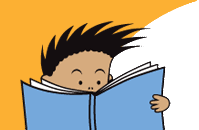My feature this week is on retelling, an important skill which demonstrates comprehension of a story. Reading requires three different processes: decoding (reading the words correctly), fluency (reading the words smoothly so that reading sounds right), and comprehension (understanding the story).  When a reader is reading well, all three of these areas are working and a book is easy to read and makes sense. When a book is too difficult, it is because a reader is struggling with one or more of these areas. When a reader struggles to read the words, it is very apparent to the listener that a book is too difficult. However, when a reader cannot remember important details about the story after reading, this also indicates that a book is too difficult. Sometimes this lapse of memory is due to a reader “taking a vacation” during reading. I find myself doing this sometimes. I am thinking about my grocery list while I’m reading, and my eyes have “read” an entire page! My brain was not concentrating when I was reading, so I couldn’t remember what I had read. This skill of staying engaged during reading may need to be practiced so that a reader can remember the story and can effectively talk about the details afterward.
When a reader is reading well, all three of these areas are working and a book is easy to read and makes sense. When a book is too difficult, it is because a reader is struggling with one or more of these areas. When a reader struggles to read the words, it is very apparent to the listener that a book is too difficult. However, when a reader cannot remember important details about the story after reading, this also indicates that a book is too difficult. Sometimes this lapse of memory is due to a reader “taking a vacation” during reading. I find myself doing this sometimes. I am thinking about my grocery list while I’m reading, and my eyes have “read” an entire page! My brain was not concentrating when I was reading, so I couldn’t remember what I had read. This skill of staying engaged during reading may need to be practiced so that a reader can remember the story and can effectively talk about the details afterward.
First and second graders are still developing this skill. To support your child’s comprehension, stop several times while reading, and see if he/she can tell the Who? and the What? for the story.  When the story is finished, guide your child through retelling the important events of the story across his/her fingers, using specific details (characters’ names and places) and remembering what happened first, next, then, etc. Can your child do this without looking back into the book?
When the story is finished, guide your child through retelling the important events of the story across his/her fingers, using specific details (characters’ names and places) and remembering what happened first, next, then, etc. Can your child do this without looking back into the book?
Retelling provides an important foundation for readers to recall details and to support their answers in discussions or in writing. Above all, we need to teach children that reading is not just about reading the words. Reading is also about being mindful so that we know what we have just read. With brains fully engaged to read the words and think about the story, readers can experience that moment when they fall into a book… that is when reading really happens!
Happy reading!




